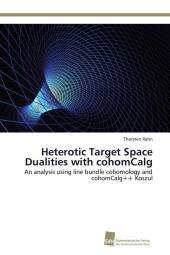 Neuerscheinungen 2012Stand: 2020-01-07 |
Schnellsuche
ISBN/Stichwort/Autor
|
Herderstraße 10
10625 Berlin
Tel.: 030 315 714 16
Fax 030 315 714 14
info@buchspektrum.de |

Thorsten Rahn
Heterotic Target Space Dualities with cohomCalg
An analysis using line bundle cohomology and cohomCalg++ Koszul
Aufl. 2012. 232 S. 220 mm
Verlag/Jahr: SÜDWESTDEUTSCHER VERLAG FÜR HOCHSCHULSCHRIFTEN 2012
ISBN: 3-8381-3393-5 (3838133935)
Neue ISBN: 978-3-8381-3393-5 (9783838133935)
Preis und Lieferzeit: Bitte klicken
String theory is a promising candidate for a theory that unifies all the fundamental forces, including gravity, to a theory of everything. Heterotic string theories are in particular interesting since they naturally carry an exceptional gauge group that can be broken down to the standard model gauge group. These theories live in ten dimensions, where six of them constitute a so called Calabi-Yau space. Ultimately all the physical quantities, e.g. the spectrum, depend on the topology of this space and, if it is given as a sub-variety of a toric variety, these quantities can be derived by the cohomology of line bundles on the ambient space. Many such cohomology groups have to be calculated and, hence, the first part of this book is devoted to the development and the mathematical proof of a theorem that allows for a very efficient way to compute them. Furthermore applications and generalizations are presented. In the last chapter a duality between string models, called target space duality, is investigated in depth. A method to generate topologically distinct string models that all share the same physics is conjectured and supported by a large scan of over 80,000 geometries.
Dr. Thorsten Rahn started his studies in 2003 at the University of Hanover. 2007 he went to the University of Adelaide, where he was awarded the Graduate Certificate in Physics. After finishing his Diploma in 2009 at the Institute for Theoretical Physics in Hanover he moved to Munich and got his PhD at the Max Planck Institute for Physics in 2012.


